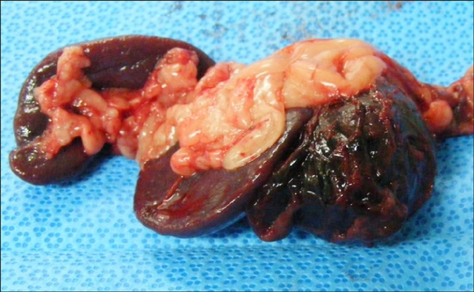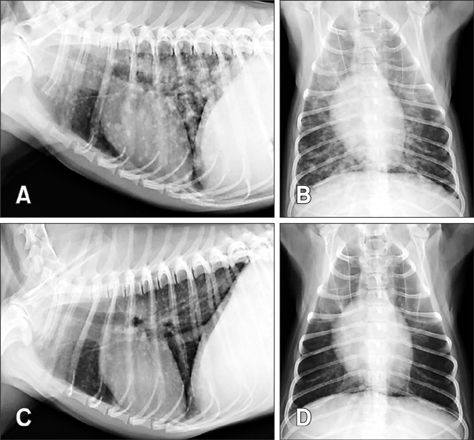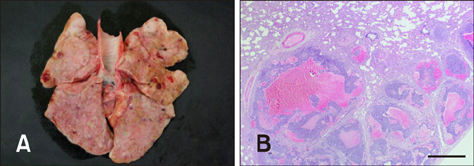J Vet Sci.
2017 Jun;18(2):257-260. 10.4142/jvs.2017.18.2.257.
Effects of neural stem cells and 5-fluorocytosine in canine metastatic lung tumor
- Affiliations
-
- 1Veterinary Medical Center, College of Veterinary Medicine, Chungbuk National University, Cheongju 28644, Korea. ghkim@cbu.ac.kr
- 2Division of Neurology, Department of Medicine, UBC Hospital, University of British Columbia, Vancouver, British Columbia V6T2B5, Canada.
- KMID: 2412580
- DOI: http://doi.org/10.4142/jvs.2017.18.2.257
Abstract
- This is the first case report to describe the tumor regressive effect of systemic human neural stem cell (NSC)/5-fluorocytosine (5-FC) therapy on canine metastatic lung tumor. The therapeutic effects appeared approximately two weeks after 5-FC administration. Thoracic radiographs revealed a reduced number of lung nodules and decreased nodule size. However, there were no significant antitumor effects on primary lesions in abdominal organs. In conclusion, human NSC/5-FC prodrug therapy can secure patient quality of life with the same or more therapeutic effects and fewer side effects than other recommended chemotherapies.
MeSH Terms
-
Animals
Antineoplastic Agents/administration & dosage/*therapeutic use
Combined Modality Therapy
Dog Diseases/diagnostic imaging/pathology/*therapy
Dogs
Flucytosine/administration & dosage/*therapeutic use
Genetic Therapy/methods/veterinary
Hemangiosarcoma/pathology/therapy/*veterinary
Lung Neoplasms/pathology/secondary/therapy/*veterinary
Male
Neural Stem Cells/metabolism/*transplantation
Prodrugs/administration & dosage/therapeutic use
Radiography, Thoracic/veterinary
Splenectomy/veterinary
Splenic Neoplasms/secondary/surgery/veterinary
Stem Cell Transplantation/methods/*veterinary
Antineoplastic Agents
Prodrugs
Flucytosine
Figure
Reference
-
1. Aboody KS, Najbauer J, Schmidt NO, Yang W, Wu JK, Zhuge Y, Przylecki W, Carroll R, Black PM, Perides G. Targeting of melanoma brain metastases using engineered neural stem/progenitor cells. Neuro Oncol. 2006; 8:119–126.
Article2. Clifford CA, Mackin AJ, Henry CJ. Treatment of canine hemangiosarcoma: 2000 and beyond. J Vet Intern Med. 2000; 14:479–485.
Article3. Eggenhofer E, Luk F, Dahlke MH, Hoogduijn MJ. The life and fate of mesenchymal stem cells. Front Immunol. 2014; 5:148.
Article4. Falk H, Herbert J, Crowley S, Ishak KG, Thomas LB, Popper H, Caldwell GG. Epidemiology of hepatic angiosarcoma in the United States: 1964-1974. Environ Health Perspect. 1981; 41:107–113.
Article5. Joo KM, Park IH, Shin JY, Jin J, Kang BG, Kim MH, Lee SJ, Jo M, Kim SU, Nam DH. Human neural stem cells can target and deliver therapeutic genes to breast cancer brain metastases. Mol Ther. 2009; 17:570–575.
Article6. Kim SK, Kim SU, Park IH, Bang JH, Aboody KS, Wang KC, Cho BK, Kim M, Menon LG, Black PM, Carroll RS. Human neural stem cells target experimental intracranial medulloblastoma and deliver a therapeutic gene leading to tumor regression. Clin Cancer Res. 2006; 12:5550–5556.
Article7. Lamerato-Kozicki AR, Helm KM, Jubala CM, Cutter GC, Modiano JF. Canine hemangiosarcoma originates from hematopoietic precursors with potential for endothelial differentiation. Exp Hematol. 2006; 34:870–878.
Article8. Lee SH, Chung YN, Kim YH, Kim YJ, Park JP, Kwon DK, Kwon OS, Heo JH, Kim YH, Ryu S, Kang HJ, Paek SH, Wang KC, Kim SU, Yoon BW. Effects of human neural stem cell transplantation in canine spinal cord hemisection. Neurol Res. 2009; 31:996–1002.
Article9. McMahill BG, Borjesson DL, Sieber-Blum M, Nolta JA, Sturges BK. Stem cells in canine spinal cord injury – promise for regenerative therapy in a large animal model of human disease. Stem Cell Rev. 2015; 11:180–193.
Article10. Moe L, Gamlem H, Dahl K, Glattre E. Canine neoplasia – population-based incidence of vascular tumours. APMIS Suppl. 2008; (125):63–68.
Article11. Prymak C, McKee LJ, Goldschmidt MH, Glickman LT. Epidemiologic, clinical, pathologic, and prognostic characteristics of splenic hemangiosarcoma and splenic hematoma in dogs: 217 cases (1985). J Am Vet Med Assoc. 1988; 193:706–712.12. Schmidt NO, Przylecki W, Yang W, Ziu M, Teng Y, Kim SU, Black PM, Aboody KS, Carroll RS. Brain tumor tropism of transplanted human neural stem cells is induced by vascular endothelial growth factor. Neoplasia. 2005; 7:623–629.
Article13. Wood CA, Moore AS, Gliatto JM, Ablin LA, Berg RJ, Rand WM. Prognosis for dogs with stage I or II splenic hemangiosarcoma treated by splenectomy alone: 32 cases (1991-1993). J Am Anim Hosp Assoc. 1998; 34:417–421.
Article14. Yi BR, Hwang KA, Kim YB, Kim SU, Choi KC. Effects of genetically engineered stem cells expressing cytosine deaminase and interferon-beta or carboxyl esterase on the growth of LNCaP rrostate cancer cells. Int J Mol Sci. 2012; 13:12519–12532.
Article15. Yip S, Sabetrasekh R, Sidman RL, Snyder EY. Neural stem cells as novel cancer therapeutic vehicles. Eur J Cancer. 2006; 42:1298–1308.
Article
- Full Text Links
- Actions
-
Cited
- CITED
-
- Close
- Share
- Similar articles
-
- Anti-proliferative Effect of Engineered Neural Stem Cells Expressing Cytosine Deaminase and Interferon-β against Lymph Node–Derived Metastatic Colorectal Adenocarcinoma in Cellular and Xenograft Mouse Models
- Stem cell properties of cells derived from canine periodontal ligament
- Critical diagnostic and cancer stem cell markers in neoplastic cells from canine primary and xenografted pulmonary adenocarcinoma
- Effects of Propofol in Voltage-dependent Potassium Channels in Human Neurl Stem Cells
- Metastasis prognostic factors and cancer stem cell-related transcription factors associated with metastasis induction in canine metastatic mammary gland tumors




